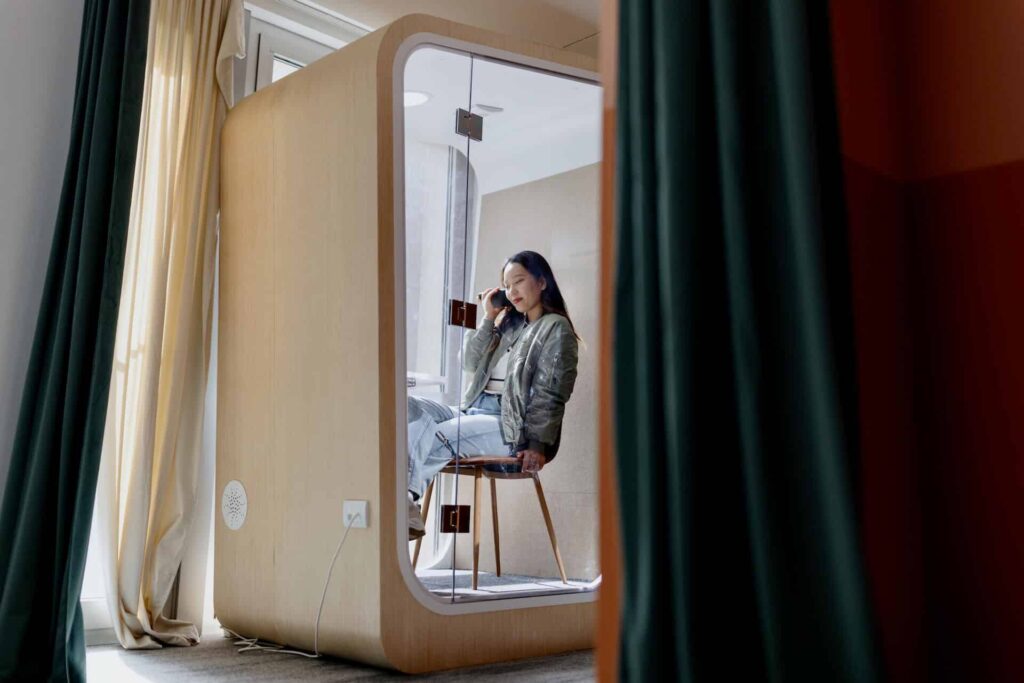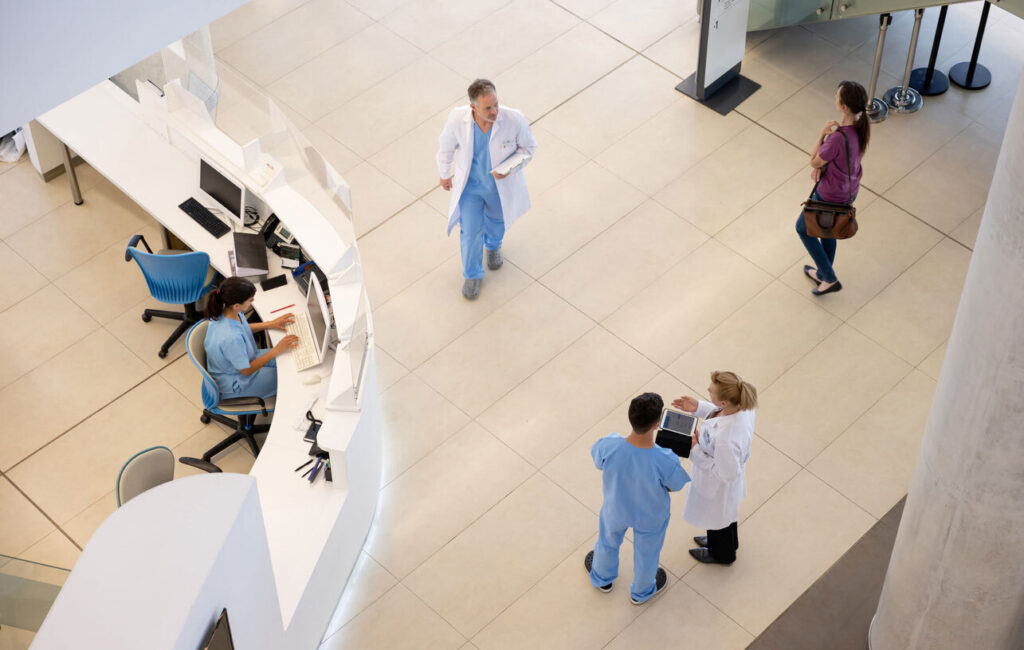The physical office: how to optimize hybrid physical workspaces
By Nick Mason• 12 mins read•February 22, 2023

The way we view the physical office post-pandemic may have changed, but one fact remains: good physical workspaces are still critical for most businesses.
Yes, thanks to hybrid and distributed work, many companies may be able to right-size (and possibly shrink) their real estate portfolios.
But the future of work still very much relies on well-planned and well-managed physical workspaces. This is where employees can gather to brainstorm, collaborate, and socialize. And depending on their circumstances, there will usually be employees who appreciate a quiet space for heads-down work, too.
In this article, we explore the new and critical role of the physical office in a hybrid world. We’ll also share tips for optimizing the physical workspace to better meet the changing needs of both employees and employers.
How the physical workspace impacts employee experience today
The role of physical office space was changing long before the pandemic forced everyone into remote and then hybrid work.
In fact, studies show that remote work increased by 400% in the period between 2010 and 2019. I.e.: one year before the pandemic.
And by the end of 2019, a whopping 36% of employees worked remotely at least one day a week, i.e. well more than a third of workers were hybrid before Covid.
Along with introducing the many benefits of working remotely, this shift is also changing how we view work. Along with where we think work needs to happen.
Namely, as workplace strategies become more human-centric, the way we work is getting more focus than where we work.
But, just as critically, companies are beginning to realize that where we work impacts how we work, too. And the work that gets done in the physical workplace tends to be the high-level, hugely important collaboration work that drives culture, employee engagement, and innovation in the workplace.
When designed and used properly, the physical workspace can have a dramatic positive impact on employee experience, helping to promote workplace wellbeing and foster a more employee centric culture.
This in turn can help support existing talent retention and attraction efforts.
“In the right circumstances, the office can 100% be supportive of a company’s culture,” says OfficeSpace CEO David Cocchiara. “But I also think the inverse is true. The physical office can have a negative impact on culture if people are not engaged when they’re there.”
The solution to this challenge?
Companies need to always keep in mind how any changes to their physical environment will impact overarching plans for the hybrid workplace and the employee experience.
Like we’ll cover next, even when trying to reduce their corporate real estate footprint, companies will need to ensure the focus in workspace design remains on improving the hybrid workplace experience for employees.
Space management in today’s physical office environment
Because of fluctuating space utilization in a hybrid office, many companies are taking this opportunity to right-size their current office space. This is often a smart move, given that the average yearly cost of corporate space rental in New York is $14,800 per employee, for example.
With fewer workers in the office on any given day, many companies are looking to reduce space to save costs.
Others are taking the opportunity to completely reassess how they use their space. They’re hoping to redesign and redefine the office to better support the work done there. I.e.: collaboration, culture and team building initiatives, video conferencing, and perhaps heads-down work.
Of course, real estate forecasting in a dynamic environment is incredibly challenging.
That’s why, before making any major office design changes, OfficeSpace Senior Product Manager Kathleen Williams recommends using advanced workplace analytics to gain better insight into how employees are using space day-to-day.
“How reversible are the decisions you are being asked to make?” she asks. “The more impactful they are, the more you want to have both high confidence and longer views of the data.”
The importance of data in space planning
For example, short term optimizations like shutting off air conditioning on a few floors or consolidating people in specific areas can usually be made easily with simple workplace data.
But optimizations with a bigger impact—like shutting down or restructuring company headquarters, say—requires more long term metrics you can trust.
Moreover, strategic space management requires space planners to actively test new configurations and carefully monitor and analyze the results.
For example, before getting rid of those headquarters, the company may decide to sublet a few floors first.
“As a rule of thumb, I’d say the bigger the decision and the higher the stakes, the more you’re going to need more confidence in your data,” says Williams. “Especially if you won’t be able to reverse your decision. You’ll need multiple data sources and more time to view the data and feel good about the trends you’re seeing.”
As we’ll cover further below, focusing on both employee experience and the right workplace data analytics can help create a better physical office for the team members using it.
What is the difference between office space and workspace?
‘Office space’ and ‘workspace’ are often used interchangeably, although they’re not exactly synonymous..
‘Office space’ generally refers to the specific physical location owned (or rented) by a company, where employees gather to work.
Meanwhile, ‘workspace’ refers to any space where work is done. ‘Workspace’ can reference either a physical or virtual office—or any combination of the two, as most companies now manage.
And of course, in today’s world, work is often done online. Even traditional workers in traditional offices need the right mix of apps and software to communicate and tackle projects.
That’s why today, when people use the term ‘workspace,’ they’re often referring to the digital workspace. The digital workspace is what unites all workers in a company, no matter where they’re logging in. With good digital workplace solutions, all you need is a reliable internet connection to access your projects, your co-workers, your calendar, and all your other workplace collaboration tools.

What is the importance of having a physical office? Do you still need one?
Yes—the office is here to stay, and most companies very much need one. But its importance and how it’s used is shifting.
Indeed, the OfficeSpace 2023 Workplace Strategy Report makes it very clear that the physical office now has two primary functions:
- To increase collaboration
- To improve company culture
Remote-first companies existed before the pandemic, and they’ll exist after (often as startups and/or tech companies). And some companies remain unwilling or unable to accommodate any remote work.
But the majority of companies today are embracing hybrid work models to help them stay agile and competitive in the future of work.
In fact, 99% of companies surveyed in the Workplace Strategy Report have employees in-office a minimum of one day per week. Moreover, 50% planning on some sort of mandate for office use in the near future.
Given these trends, it’s safe to assume that any type of business that needed an office in the past is going to want one going forward, perhaps moreso.
Of course, having a physical office provides companies with a mailing address and all the necessary trappings of an ‘official’ business. Which is why even many small businesses dedicate precious funds to real estate portfolio management.
And some companies will need physical spaces for specific, often client-facing activities or other business needs.
But beyond this, even companies that are looking to cut costs are often reducing their physical presence, not cutting it altogether.
That’s largely because of the outsized positive impact that face-to-face interaction with coworkers will always have on collaboration and culture.
The physical workspace and collaboration
Like Michelle Kaufmann, Director of Real Estate Research and Development at Google, insists,
“collaboration works best when employees can see and be seen, and hear and be heard on any project.”
Consider what we’ve learned from recent research:
- Companies that promote collaboration in the workplace are five times more likely to be high-performing
- Employees that engage in collaboration are 17% more satisfied with their jobs
- Promoting collaboration strategies in the workplace can reduce turnover rates by 50%
And, even more important when assessing the value of the shared office, consider that idea generation (the hallmark of collaboration and brainstorming), is best accomplished face-to-face. In short, in-person time with coworkers matters.
Of course, Slack, Zoom, and other hybrid working tools have allowed companies to shift to hybrid en masse without negatively impacting productivity or engagement.
But OfficeSpace’s 2023 Report also shows that 65% of leaders want employees in the office more frequently to improve collaboration.
And 35% of companies will be remodeling in the coming year(s) to offer more collaboration space.
This may be to accommodate new, more collaborative working styles. Perhaps they’ll be adding new huddle rooms, for example. Or embracing new meeting room setup styles to better accommodate smaller and/or mixed presence meetings.
To ensure they’re continuously following hybrid meeting best practices, companies may also adopt meeting room booking software. This makes it easy for employees to book rooms in real-time or in advance. Meeting room digital signage that simplifies wayfinding is also becoming popular.
And finally, companies will still want to foster ad hoc, impromptu collaboration. Note that some of the best teamwork happens spontaneously, outside a booked conference room.
Of course, by definition, you can’t specifically plan for ‘impromptu’ collaboration. What you can do is help employees coordinate their flexible, hybrid schedules, with those of their colleagues.
The importance of coordinating hybrid schedules
Like Lenny Beaudoin, Executive Managing Director of CBRE Workplace Strategy reminds us, “the most important amenity in the return to the office is other employees.”
If companies want their employees to engage in quick huddles and impromptu whiteboard sessions, then they’re going to have to ensure employees are in-office at the same time.
And if they want to avoid office use mandates (and the lack of enthusiasm that generally meets them), then they need a tool like Who’s In?. This is an enhanced visual directory that lets everyone see whether their colleagues have booked time to work in-office. Then, they can come in accordingly.
Many companies are also exploring things like all-hands meetings, team retreats, and modern office floor plans. These can all help spark ideas, by allowing for more inter-departmental and/or cross-functional collaboration than would otherwise happen.
The office is a place that should encourage collaboration and foster culture, help people grow individually, and help everyone be more productive.
OfficeSpace CEO David Cocchiara
The physical workspace and company culture
According to PwC surveys, “36% of executives say the loss of corporate culture is the biggest challenge to hybrid work.” This dovetails with the latest OfficeSpace Workplace Strategy Report. It found that 59% of surveyed workplace leaders say they want employees in the office to build company culture.
To accommodate this culture push, 31% of companies are also planning to remodel for enhancing socialization. According to 2022-2023 CBRE Global Workplace & Occupancy Insights report, for example, 71% of companies offer a barista bar at their headquarters, 67% offer walk-up tech support, 63% offer community and/or public spaces, 38% offer outdoor space, and 37% offer a massage or meditation room.
In other words, companies are moving beyond endless rows of beige cubicles. They’re moving into dynamic spaces that encourage social interaction and a sense of belonging (i.e.: that foster culture). More ‘me’ space is becoming ‘we’ space, because seeing people in-person builds relationships. It also helps instill a sense of community that is incredibly difficult to otherwise cultivate with a fully distributed workforce.
“There’s something beautiful about having a team who have a lot of shared experiences that they’ve built over the course of multiple years working together,” says Taylor Graves, OfficeSpace Senior People Operations Manager. “If people don’t feel connected with their teams, it’s easier for eyes to wander to other companies. But if you’re spending time with your teammates in person, you end up valuing those relationships more and being less inclined to leave them for seemingly greener pastures.”
Things like in-person events and games can all have a positive impact on culture, too.
“The office itself, how people feel like they’re engaging and collaborating, will both have a positive impact on culture.”
David Cocchiara

What are the different work environment types that can increase collaboration and company culture in the physical workspace?
First and foremost, the highly flexible, highly collaborative hybrid workplaces that are emerging today typically demand some amount of flexible seating. Not only will shared, bookable desks help maintain a better office density in a space that varies between peak, average, and low occupancy rates, they also get people moving around the office. Instead of the same desk neighbor each and every day of your career, now you can sit next to a new colleague every day of the week.
Like we’ve covered, a visual directory that provides visibility into the location and schedules of your colleagues can also make sure people are connecting with people in all sorts of different contexts.
Beyond this, companies are also experimenting with a variety of new work environment types. These are specifically designed to enhance collaboration (among other benefits). These environment types include:
- ABW: Activity-based working, which creates different areas in the office for different types of activities (i.e.: open spaces for collaboration or phone booths for private calls)
- Working neighborhoods, which use office neighborhood software to group workers by certain characteristics (often by department, project, or preferred working style) and then create neighborhood layouts to assign these groups to the same area in the office
- Agile working, which lets workers choose when, where, and how they work, requiring complex layouts to accommodate continuously varying office use
- Hot desking and office hoteling, two popular flexible seating approaches that allow employees to share desks depending on who’s in the office (best supported with a mobile app that lets them book, check-in, and cancel reservations easily)
Beyond these more flexible work arrangements, companies may also experiment with fun, new flex room ideas, for all those spaces that are currently underutilized in the office.

How to make a better physical workspace for everyone
When looking to make people-centric physical workspaces, any investments or divestitures in real estate need to match company culture. Companies need spaces and technology that help them connect strictly remote workers, strictly in-office workers, and everyone in between.
Workplace agility is critical here. Like we’ve covered, companies will need to test different strategies and scenarios, carefully track the results, and adjust accordingly. Workplace reports and analytics, ideally coupled with office scenario planning software, can dramatically simplify this process.
It’s difficult to overstate the importance of data in this process. In fact, according to the CBRE, 91% of respondents in their Global Workplace & Occupancy Insights Report are using utilization data to improve occupancy planning. Like the authors stress, “utilization data is the key to understanding the new realities of hybrid working environments.”
Companies can collect this critical data from space management software (tracking things like desk bookings and room reservation). They can also collect it from occupancy sensors, employee badge data, and wifi logs. Ideally, in fact, they’ll use all of the above. Indeed, combining these data sets can help to create a fuller picture of true office utilization. This can ensure you have more confidence in what you’re seeing and/or planning.
“My advice to companies is that you can’t rely on just one source of data,” says Williams. “Unstructured data won’t cut it anymore. You need to bring your large datasets together to truly solve business problems.”
Beyond this, and beyond exploring the previously mentioned new work environments, companies should consider the following best practices when looking to rejig the physical office to better serve the people who use it.
1. Provide well-supported spaces
People have always needed tools to do their jobs. But hybrid employees need a lot more than a laptop and an ergonomic desk these days.
Specifically, they need bookable spaces. And a way to access these spaces easily (i.e.: flexible working software that lets them book and use spaces from their preferred platform… including their phones). Even better if IoT sensors simplify this process further, by ‘checking in’ for them.
Of course, if they’re sharing desks, then employees will have less space for their ‘stuff.’. That means that in addition to bookable spaces, they should also have somewhere to store their personal belongings. This is often a locker. Each desk will also need to be equipped with good monitors, keyboards, and any other technical equipment.
Employees also need good wayfinding tools, including a visual directory, wayfinding signage, and possibly digital wayfinding kiosks. These should all work seamlessly together to help them easily find rooms, technology, equipment, and—critically—each other.
Finally, employees who work remotely for any amount of time will need a home office that also has the tools and technology they need to perform well. This may require stipends to help them outfit their own space as needed.
2. Provide comfortable and engaging spaces
If leaders want their employees to use the office more, then they need to ensure it’s a welcoming place. People are only going to feel compelled to linger, collaborate, and/or socialize in clean, attractive, accessible, and well-designed spaces.
Specifically, employees need a nice space to eat, meeting rooms and break out spaces to collaborate, and comfortable furniture to relax and hang out. The more desirable the space is, the more people are likely to use it.
“We want to make the office experience appealing for employees.”
OfficeSpace Senior People Operations Manager Taylor Graves
3. Provide fun spaces
Similarly, companies need to provide fun spaces and activities for employees. This helps to encourage the relationship-building and connection that is so good for both collaboration and culture.
This will look different for every company. The Victoria branch of OfficeSpace, for example, keeps a deck of ‘Dutch Blitz’ cards on hand. So small groups can play a quick hand of cards as a refresher between meetings. Free lunches are quickly becoming a staple of offices, as are Game Days (best held during work time so that people don’t feel they have to commit their personal time to work events).
Note that companies struggling to come up with good ideas have a simple way to figure out what their employees would like: just ask them!
“I want to act with employees’ best interest in mind, and what better way to do that than to ask people directly?” says Graves.

Why is physical workspace important?
The physical workspace is important for the same reason employee empowerment is important: work is done by people. People do their best work when they have safe and well-designed spaces. And when they’re able to build solid relationships with those around them.
OfficeSpace enhances the physical office with software that makes it easy to plan and implement better workspaces for those who use them. Reach out for a free demo.
Images: FreshSplash, PrathanChorruangsak, Anchiy, courtneyk, mihailomilovanovic




